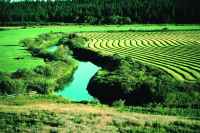| | This manual has been prepared for you, an Alberta crop producer, to provide information about a wide range of beneficial management practices (BMPs) suited to crop production in Alberta. BMPs are practices that benefit the environment while being practical for producers to meet or exceed legal requirements.
BMPs improve a farm's soil, water, air and wildlife habitat resources, and so contribute to the farm's overall sustainability and to the farm family's quality of life. BMPs also contribute to the environmental health of the surrounding landscape and communities.
Chapter 2 describes the environmental considerations related to crop production. Chapters 3 to 7 discuss farming practices that reduce or prevent impacts on soil, water, air and wildlife habitat. Chapters 8 and 9 describe community and legal considerations in crop production. Chapter 10 is a glossary of terms used in the manual; words defined in the glossary are highlighted in bold when they first appear in the main text of the manual. The manual provides both metric and imperial units in most instances; information on converting units is provided at the end of the manual.
This manual is aimed at producers who are striving for excellence in environmental stewardship. Therefore, many of the practices described in Chapters 3 to 7 go beyond the basic legal requirements, outlined in Chapter 9, that Alberta producers must meet.

Beneficial management practices contribute to a healthy landscape.
Courtesy of ARD
Each farm is unique. Not all of the practices in the manual are suited to every cropping operation. You will need to consider the various options, choose those best suited to your needs, and adapt them to the specific conditions on your farm.
If you are an experienced crop producer, this manual can help you enhance your stewardship of the environment. If you do not have a strong knowledge of crop production, you will need to consult other information sources - such as experienced farmers in your area, college and university courses, other publications, and professional agronomists - because all aspects of farm management need be taken into account when deciding on the best practices for your farm.
Back to Chapter 1 - Introduction |
|